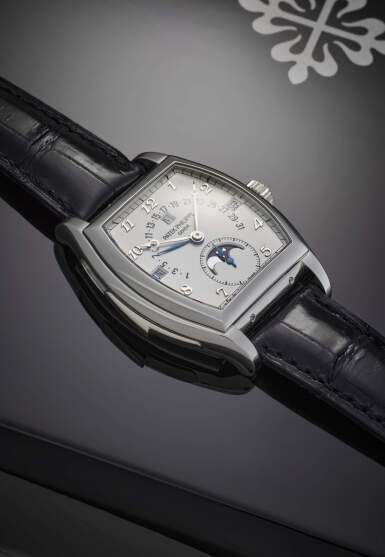
Property from an Important Californian Collector
Patek Philippe
Reference 5013P | A platinum tonneau shaped minute repeating perpetual calendar wristwatch with retrograde date, moon phases and leap year indication, Made in 1999
Auction Closed
June 10, 05:33 PM GMT
Estimate
300,000 - 400,000 USD
Lot Details
Description
Dial: silvered
Caliber: cal. R27 PS-QR automatic, 41 jewels
Movement number: 1’908’032
Case: platinum, snap on case back
Case number: 2’972’572
Closure: platinum Patek Philippe buckle
Size: 46 x 35 mm
Signed: case, dial, and movement
Box: yes
Papers: no
Accessories: Patek Philippe presentation box with outer packaging, Extract from the Archives confirming year of manufacture in 1999 and date of sale on 16 December 1999, leather bi-fold, booklets, and service hangtag.
Reference 5013 was introduced in 1992 and remained in production until 2011. It held the title of Patek Philippe’s most complicated serially produced wristwatch until the debut of Reference 5016 in 1994. A groundbreaking milestone for the brand, the 5013 was the first wristwatch to combine a self-winding movement with a minute repeater, retrograde date, and perpetual calendar. Depending on the month and leap year cycle, the date hand automatically jumps back to the first after the 28th, 29th, 30th, or 31st.
Minute repeaters are traditionally powered by manual-winding movements, making Patek Philippe’s creation of a self-winding version in 1989 a remarkable technical achievement. The movement used in Reference 5013—Caliber R 27 PS QR—was born from the extensive R&D behind the brand’s first automatic minute repeaters developed to celebrate its 150th anniversary. The movement alone comprises an impressive 515 components.
The 5013 was offered in yellow, pink, and white gold, as well as platinum. Despite its lengthy production run, it is believed that only 101 examples were made, with just 45 cased in platinum—underscoring its rarity and desirability. For collectors, the Reference 5013 represents a pinnacle acquisition: not only for its technical complexity and historical importance, but also for its exceedingly limited production.
